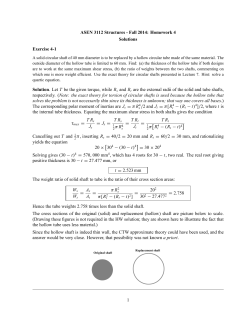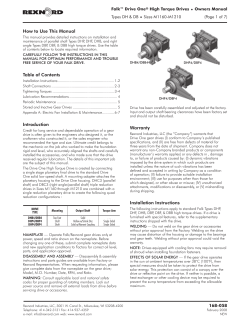
A new prototype paradigm How to make things 5/25/2010
5/25/2010 A new prototype paradigm How to make things Robin Coope Engineering Group Leader BC Cancer Agency Genome Sciences Centre With help and examples from Dan Gelbart, Bernhard Zender and Jon Nakane The New Approach • When the designer can build his/her own prototypes quickly, the pace of R&D is greatly accelerated, • No formal documentation is needed. • Change design on the fly to for materials on hand or fabrication errors. • No need to communicate design details to others • Traditional prototyping via CNC machining of aluminum blocks is • Too slow (requires careful CNC programming) and expensive in time and materials. • Student engineers can not be taught to become a machinist in a short time. • Turnaround for even simple prototypes is at least days, even in well run places. Any changes require a new iteration and delays. • The great majority of parts can be made in a few hours by the designers, without formal drawings or CNC programming, of formed sheet metal or minimally machined plate. •The more innovative the project is, the more likely it is that many rounds of prototyping will be needed. Cutting each cycle from days to hours has a major impact. Source: Dan Gelbart Start with a sketch Example Project: Improving the Multiplate Vortexer Three deep well plates per holder, four holders total Solidworks Solidworks 1 5/25/2010 Solidworks To OMAX Layout…. …And the Water Jet Cutter 2’ x 4’x 1.25mm mild steel Can cut metal, plastic, rubber stone, glass, wood Cut Parts Bend and Spot Weld 2 5/25/2010 Quick Corrections Quick Corrections Sand Blast and Powder Coat Fabrication Time: Two Hours Other Advantages An $800 Part, or, why engineers need shop time. • The designer/engineer/researcher will gain more and more experience from this process so his/her designs will actually get more efficient over time. • Parts made this way can be easily scaled to production through simple machining or production waterjet or laser cutting 3 5/25/2010 Hierarchy of Design 1. 2. 3. 4. Figure out what you need. See if you can buy it somewhere.. Try to design it with no post-waterjet machining Try to make it from sheet, with only bends, spot welds and weld nuts/studs 5. Design it with added screw threads only – use more than one part if need be. 6. Design a machined part with as much of the difficult machining done by waterjet as possible. A Gelbart Box Design Examples A Gelbart Box Step 4: Nut/ Stud Welding and Spot Welding Note bent electrode for access under a lip. A Gelbart Box Simple Part Stack Electrode Holder from the GSC’s Size Selection Robot. Stacked Simple Parts are used here rather than any machining. Only threads are tapped 4 5/25/2010 A Prototype Medical Tool All parts except for the turned parts were done by waterjet cutting, bending and spot welding. Total fabrication time (not including design) is about 8 hours. (Dan Gelbart) Precision Parts Cut from 12.7mm aluminum plate, painted, then machined at the critical areas. Total fabrication time 2-3 hours per part. (Dan Gelbart) Complex Shapes Flexure High Density Polyethylene Or Delrin A QC device for prostate brachytherapy A mounting system for two wiring boards which allow the boards to be removed without tools Project Mango! Design Informed by Physics or How to Have Structural I t iti Intuition You can never be too young, too rich or too thin - Wallis Simpson, Famous divorceé You can never be too light, too stiff or have too much torque - Autonomous Actuator Truism 5 5/25/2010 Making Things Stiff Bends 27mm @ 5 Newtons A 100x200mm piece of 24ga (0.6mm) mild steel Fixed Here Force = 5N 0.34mm @ 5N (0.39mm with 15mm sides) Closed Box: 0.013mm under 5N! Fixed Here Fixed Here Force = 5N 25mm sides Force = 5N Deflection Deflection y(x) y max y max 3 4WL Ebd 3 Stiffness thickness3 WL3 3EI BD 3 HK 3 I 12 The strength-to-weight ratio depends on getting material farther from the neutral axis, without introducing other bending modes 6 5/25/2010 Closed Structures Good Robot Design • Optimized forces • Tidy wiring, good connectors and easy to remove boards. • Low force mechanisms • Torque is the enemy. Stiff! Not so stiff! Closed structures prevent twisting into less stiff configurations Good Robot Design F a m Drive Train Optimization Minimize mass to maximize acceleration and minimize rolling resistance , T Acceleration: I mi r 2 i Place masses close to the center of gravity to minimize yaw moment a = F/m F = T/r a ~ 1/r r Speed: vmax = max r Important: Driving forces >> friction/load Gear Ratios N2 teeth N1 teeth , T2 Torque: Slower = more torque. , T1 Parts for the 2010 Race Car Bot Angular velocity: Faster = less torque There are practical limits to the torque you can transmit through gears. Meccano gears will split under excessive torque 7 5/25/2010 The Importance of Solidworks Lazy Susans, Gears and Racks The best approach now is to learn Solidworks really well and design the robot as completely as possible. Include all offthe-shelf parts w/ masses. Add wires if possible. Steering: Ackerman Angle Bumpers King pin 1. Tie rod Good approximation to ideal Ackerman angle 2. Source: http://en.wikipedia.org/wiki/Ackermann_steering_geometry Fasteners Fasteners Machine Screws 2-56/4-40/8-32 Rivets POP i t POP-rivets Loctite thread fastener. adhesives etc Epoxy 8 5/25/2010 Adhesives Key Holes and Standoffs Adhesives in the 253 lab: • Epoxy • Cyanoacrylate (superglue) • Hot glue • Adhesive tape (double sided) • Loctite Remember to clean and degrease surfaces to be glued. Images from MIT 2.007: http://pergatory.mit.edu/2.007/lectures/lectures.html Shafts, Wheels, Transmissions •Shafts should only be supported at 2 points – use flexible couplings as needed – eg servo potentiometer •Supporting either side of gears is better. •Bearing choice is determined by speed, load, & cost. Clamping to Shafts II Set Screws Positives: Easy to make, can use on any shaft. Negatives: Can mar the shaft, not much torque resistance, easy to strip 4-40 set screws, need to use shaft flats for better grip larger shafts. Best used with small shafts – eg Physics 253 robots! Best used for bushings, not torque loads. Clamping to Shafts I Splines. Great torque resistance. Can be endbolted if the spline is tapered or split bolted (e.g. Futaba servo output). A loose fit will “nag” the splines and wreck the shaft. Can also be used for longditudinal sliding torque transfer. Woodruf keys: A single spline for a steel shaft and hub. Material of the key (e.g. brass) is chosen so it can break under a specified load, as a safety mechanism. Clamping to Shafts III The best method for torque resistance without spines is a split clamp. MUST have an accurate fit to the shaft before the screw is tightened. Actuator Machine Screw No threads Cut out Threads Rigid Link Shaft 9 5/25/2010 Wheels and Hubs Tire Wheels • The key to good hubs for gears and wheels is concentricity and good grip. • Shaft fits should be tight to prevent vibration. •Make hubs long enough to make set screws accessible • Good hub/shaft overlap (eg ~20mm for our motors), gives good stiffness which helps keep wheels tight. Wheel Hub Motor Hub Set Screw Wheel Screws For two-part wheels and gears, the mechanism for tightening onto the shaft must be separate from the mechanism for holding the wheel and hub together! While the “non optimal” solution at f=F*L/d left is, yes, not optimal, in practice mounting wheel directly on motor shafts has always worked for 253 robots. robots Images from MIT 2.007: http://pergatory.mit.edu/2.00 7/lectures/lectures.html Bearings Thin Bushings – easy, quick but beware of binding! More about Bending and Spot Welding g Nylon Bushings – cheap, can make custom shapes, higher friction Ball Bearings – expensive! heavy very good alignment required. Guides from CNC back guage Top die Bottom Die Our 12 ton press brakes can bend > 120cm @ 1mm and ~ 30cm @ 2.5mm for steel The guage fingers can get in close enough to bend ~ 8mm flanges with the small die, 14mm with the large. 10 5/25/2010 Dies are cut into different lengths to allow complex bends 12 kVA spot welder can weld up to 2mm + 2mm steel. Power can be adjusted from “1” to “7” Rule: Always keep the timer on minimum: 0.1s Stiffener plates get welded either side of mitre An 8-32 weld nut going being spot welded by flat dies. The shoulder locates it in the waterjetted hole. 11 5/25/2010 Sheet Metal Rules Source: Dan Gelbart Material Sheet Metal Rules Source: Dan Gelbart Final Thoughts • Steel – Cheap, spot weldable, (Was) hard to machine, needs finishing. ~ $3/kg ($12/kg for stainless) – Density = 7.9 g/cm3 – Young Young’s s Modulus = 2000MPa • Aluminum – Forgiving to machine, low density. $12/kg – Density = 2.7 g/cm3, Young’s Modulus = 600MPa • Plastic (Polyethylene, Delrin, Teflon) – Insulating! Makes Bearings! Transparent to X-rays! – Otherwise, soft, weak and yucky • Do as much Solidworks design as you can without slowing down the team too much. • Keep p yyour design g jjust simple p enough. g • Avoid high driving forces/torques • Keep your wiring organized • Be prepared to change course if things aren’t working. • Work as a team! 12
© Copyright 2025





















